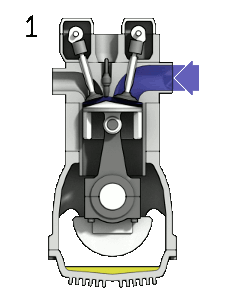RPM

RPM stands for rotations per minute and is also abbreviated rpm. This is a unit which describes how many times an object completes a cycle in a minute. This cycle can be anything, the pistons in a internal combustion engine (see figure 1) repeating their motion or a wind turbine spinning once all the way around.
The reading on a tachometer in a car gives how many RPM (usually 1000s of RPM) a car's crankshaft is turning (this is different from the number of rotations per minute that the wheels are doing, which is why it still reads ~1000 RPM while sitting at a stoplight).
Most wind turbines try to spin at about 15 RPM, and gearing is used to keep it at that speed. Gearing is also used with the crankshaft of a vehicle in order to keep the RPM reading in a range (usually 2000-3000 RPM). Some racing motorcycles will reach more than 20,000 RPM.
Rotations per minute is an especially important topic when discussing generators, as generators spinning at a higher RPM produce more power for the same amount of energy in each cycle. It's generally convenient to make the RPMs of an electric generator match the frequency of the electrical grid (or some multiple of that frequency), although grid frequency is usually measured in Hertz (Hz), rather than RPM.
Two useful conversions: 1 RPM = 0.0167 Hz and 60 RPM = 1 Hz
For Further Reading
- Crankshaft
- Gear
- Internal combustion engine
- Turbine
- Or explore a random page
References
- ↑ Zephyris (Richard Wheeler). (accessed 2015, Jan. 4). 4StrokeEngine Ortho 3D Small.gif [Online]. Available: http://commons.wikimedia.org/wiki/File%3A4StrokeEngine_Ortho_3D_Small.gif

